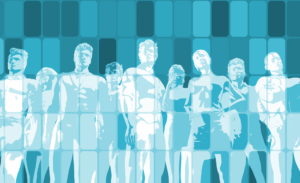
As we have seen, time and time again, each new wave and variant of the Covid-19 virus is followed by a massive upheaval of the working world; fundamentals we once took for granted. It’s safe to say that in a post-Covid world, we won’t be reverting back to the way things were. The following are three central trends that I believe will be dramatically changing (hopefully, for the better):

#1 – Give your people’s the freedom to choose
It was once a given that, in order to ensure acceptable productivity, employees would need to clock in and out each day. Needless to say, working from home was mostly out of the question. After all, employees needed to be supervised to ensure their salaries yielded an acceptable output. This outdated paradigm was a direct descendant of the historical means of production and later, of the Industrial Revolution.
Today, this assumption has been proven to be anything but solid. The data is still coming in on work-from-home productivity, but one thing is clear: companies and industries did not crash due to reduced productivity stemming from remote work. In some industries (especially those that are knowledge-based), it’s likely that overall productivity actually increased.
Well before Covid-19, companies were already starting to rethink “control,” in terms of managerial supervision over employees. Top-down directives and micro-management were found to be suboptimal to operational models that made room for localized operational autonomy, decentralized decision-making, and general process democratization.
In terms of returning to the office (RTO), those who insist that their employees do so on a full-time basis will likely experience an exodus of key employees and top talents, leaving them with those who have fewer employment options in today’s new job market.
What motivated this change?
Reality did. Working from home became a health requirement. Within months, it was clear that it was, in fact, possible to run successful organizations without everybody coming into the office… even for months at a time. Even once it became possible to return to “normal,” employers had lost their former logical high ground, based on a long history of “how things are done.” This was compounded by the fact that companies that were quick to adapt and offer work-from-home benefits, were able to acquire new talents to their teams. Soon, the temporary pandemic–driven reality became the new “new normal.”
What does this mean for your organization?
If you were a helicopter boss before Covid-19, then you now need to stop being one immediately. Rather than overly supervising employees, give them the tools they need to be independent and motivated to succeed, and make sure you hire people who are reliable, self-starters.

#2 – Decentralize decision making
Have you ever studied a school of fish swimming in the sea? Or watched in wonder how a flock of thousands of birds move in what seems like a fully choreographed fashion? This is called Swarm intelligence (SI) which is defined as the collective behavior of decentralized, self-organized systems – both natural and artificial. It’s almost as if each fish knows which decision needs to be made at any given moment, even though there is no apparent centralized command and control leading the school.
What if organizations could adopt Swarm Intelligence? How would this affect your company’s ability to execute on its strategy or respond to rapidly and even dramatically changing market conditions (i.e. – a global pandemic!)?
I believe that the days of top-down policy making, centralized decisions, made behind closed doors, and micro-management of employees are gone. New trends and market conditions must be responded to with lightning speed and extreme uniformity. The only way to do this is by hiring the right people, affording them the right infrastructure and training them as needed – and then trusting them to do the right things (which includes failing fast and cheap).
What are your next steps?
If you find that you just can’t let go and trust your people to make decisions, your first order of business needs to be figuring out which are the weak links in your process (i.e. – hiring the right people, having the right infrastructure, or providing the right training) and redirecting more of your attention to getting them right. Micro-managing may yield you short-term results, but it will gradually drag you and your organization down, in terms of productivity and overall employee satisfaction.
Furthermore, make sure that your organization’s DNA is strong and clear, your values transparent and orderly, and your decision tree straightforward. It’s up to you to make sure that each department and employee knows what to do at any given point, so that they can act independently and successfully, at all times.

#3 – Cultivate non-functional interactions
How would you feel about sending an acquaintance of yours, someone you haven’t seen or spoken to in several years, the following text message: “Hey Julia, long time no speak! I was wondering if I might borrow your car this weekend?” Pretty uncomfortable, right?
When you think about the most meaningful relationships in your personal life, they are based on interactions and interpersonal dynamics that are “non-functional” – that is to say, they exist simply because they elicit pleasure, such as when spending time together and building positive shared memories. We don’t only reach out to our friends and acquaintances when we need them for something. If we did only call them when we needed them, it would likely stress the relationship and possibly lead to gradual distancing.
Now, think about the people in your company. When do they reach out to one another? What percent of their interactions are NOT for the purpose of getting something work-related done. “Of course,” you may say… “It’s a place of work, not a recreational setting.” That said, people are people, at home as well as at work. For them to get along and work well together, they need to have a relationship that goes beyond the functional “give and take.” That’s why team-building activities, company retreats, and holiday parties are so important.
But now, thanks to Covid and the new work from home (WFH) reality, they don’t even get to have occasional non-functional interactions in the office corridor, kitchen, or elevator. That’s why it’s crucial to create a “virtual corridor” that creates windows of opportunity for your people to “run into” each other and have casual, off the cuff, conversations. It’s also worth considering how some of the budgets saved from needing less office space and spending less on travel, can be redirected to periodic (optimally 2-3 times a quarter) “fun days,” so your people can meet and spend some quality time together. These don’t need to be fancy productions – even a company picnic or a movie night will do.
Homo Sapiens need to know and like one another to build the trust they need to work well together. Few things build this trust as well as simple and frequent non-functional interactions.
Want to ensure your organization adopts these suggestions with success in the post-Covid working world?
Ariel Halevi is a founding partner and CEO at VAYOMAR, a company that specializes in improving performance and decision-making among senior executives, sales teams, and mid-level managers. The author of “You’re Not Moving Slow Enough: The Unexpected Formula to Lasting Influence” (2016), Ariel focuses on the relationship between emotional intelligence (EQ) and people’s ability to influence others, without exerting authority. He holds a bachelor’s degree in Government, Strategy, and Diplomacy, and a master’s degree in Counter-terrorism and Homeland Security from Reichmann University.
If you liked this article you may find these interesting as well:

Winter is coming – Strategies that can help you grow even during the budgetary policies of a recession
Ariel Halevi | 12 minutes They’re cutting your budget and telling you that they still expect you to meet your goals. Financial growth without budgetary

Four Weaknesses of Executive Leadership Teams (ELT)
Ariel Halevi | 10 minutes Senior executive leadership teams (ELT) operate in all sorts of companies, from hyper- growth startups that have reached “unicorn” status

Dealing with Post-Covid Employment Disorder – A Different Approach to the Current Workforce Crisis
Photo by Parastoo Maleki on Unsplash Ariel Halevi | 5 minutes Over the past year, there’s been a hiring and talent retention crisis. Massive resignations,

